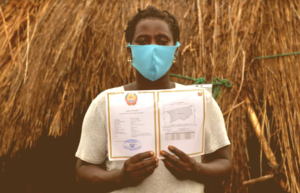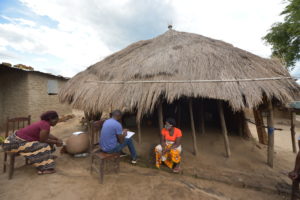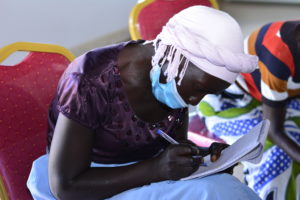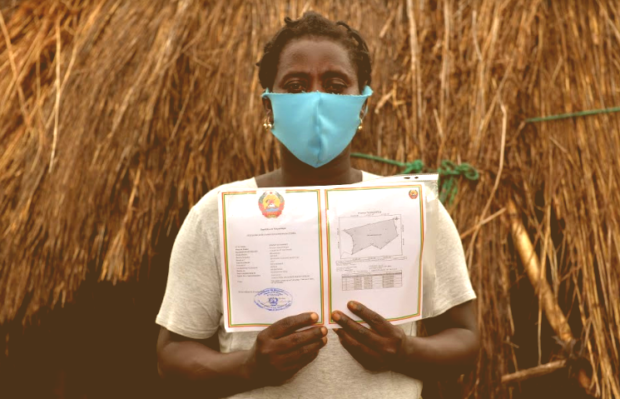By Phillan Zamchiya, Clemente Ntauazi and Joana Noyes
One of the most dramatic post-colonial developments in Africa is the rapid drive towards formalisation of property rights in land, for people who live on customary land. In sub- Saharan Africa about 90% of the land is held under customary tenure. Customary tenure can be defined as a set of rules and norms that govern allocation, use and access, control, ownership and transfer of land and other natural resources. It is imperative for policy to note that most African tenure systems include individual rights, arable lands and common property resources.
The land is usually governed under the authority of ‘traditional’ leadership, families or clans under the indigenous communities’ customs. Between 1990 and 2017 there were 32 new land laws enacted across sub- Saharan Africa, much of them with a focus on formalising rights on customary lands. The new wave of formalisation on the continent allows for surveying of boundaries, registration and documentation, leasing and transfers of customary land. This is partly meant to reduce conflict, allow for responsible investments and protect communities’ land rights.
African governments, civil society organisations (CSOs) and Western donor agencies have capitalised on the new wave to introduce flanking mechanisms (programmes that advocate for registration of customary land rights) as a way to protect the poor from the rise in demand for land. These programmes are embedded in evolutionary models of land tenure rights which pay little attention to local dynamics and their implications for women. A critical question therefore remains unanswered: how is the formalisation of customary land rights affecting tenure security for rural women and with what implications for policy makers? Some desktop studies argue that formalisation has brought better security than before.

Image by: Livaningo
For example, Wily argues that in 30 out of 47 African countries tenure reforms have brought better protection of rights through formalisation compared to the prior situation. However, recent Prindex surveys still show that in sub-Saharan Africa nearly 50% of women feared losing their land in the event of divorce or death of a spouse. Given the contested nature of outcomes, the debate can be enriched beyond statistical surveys, desktop analysis and ideological persuasions through solid ethnographic case studies.
It is from this perspective that we conducted a first phase of in-depth interviews, life histories and focus group discussions (FGDs) with 63 women who live under customary tenure in Nhamatanda district located in Sofala province, Mozambique, in February 2021. Mozambique is an interesting case study because the 1997 Land Law and its regulations provide for the recognition of customary and good faith occupation land rights, and establish the mechanisms for registering these land use rights known in Portuguese as Direito de Uso e Aproveitamento da Terra (DUAT) for individuals, communities and investors.
The Mozambique Government therefore launched the Terra Segura programme in 2015. Consistent with the state’s projects of high modernism, the programme set out to register five million (individual) DUATs, delimit 4,000 communities’ land and issue DUATs in seven years – a target that was never met. Western donors supported the programme. A more significant development was on 4 December 2018 when the World Bank Group (WBG), a long-term proponent of privations of property rights, approved 100 million USD to support the programme, with an objective to regularise two million DUATs, delimit and register 1,200 community delimitation certificates occupied by local communities in 71 selected districts (45% of the 157 districts in Mozambique). The programme targets 40% of beneficiaries to be women.
The gendered implications of such a modernisation programme were starker in Nhamatanda, where the majority of women live on smallholder agriculture in an area long ravaged by a number of cyclones, which is difficult to reach in the rainy season and located in a province where 42.2% of the population live below the poverty datum line. From our interviews, most of the vulnerable women did not know about the Mozambican Law of 1997, the Terra Segura programme and the WBG and other donor-driven processes meant to register their land rights. This showed limited public consultation in policy-making processes. For example, Dorca Domingo John, a married woman with six children, explained, “I never heard about the DUAT and I don’t know what it is”. This line of response was common amongst most women we interviewed.
Yet, consultation can increase effectiveness in implementation and enhance compliance because it generates a sense of co-ownership and legitimacy. However, a few women with better access to information through participation in local groups such as Associacao Nzeru Mbaili knew about the DUAT but did not know the process of acquiring it. Finicha Domingos, a married woman with five children attested, “I heard about DUAT certificates, I was told by a CSO that it is important to secure land in the case of conflicts but I don’t know how and where to acquire it”. Even women who planned to independently acquire the DUAT had no information about the cost. On estimation, it cost about USD 400 to register between 2-10 hectares of land which was far out of reach of indigent households in Nhamatanda.
In addition, policy makers assumed that every person wanted to register their land rights. Some of the respondents did not understand the rationale after living for decades without any paper to prove ownership. One of them explained, “I simply don’t know why I must acquire a DUAT now. I have been living and farming with my family here for many years without any document”. They complained about state officials not giving them a choice on the DUAT. As Fukuyama has argued, being able to choose is one of the cornerstones of development. Others did not believe that customary rights needed to be registered, in order for them to become secure.
A respondent explained, “Having a DUAT should be a voluntary process and not a compulsory one, but the government is forcing all of us to have it, as if it was a right mechanism to secure land. I have seen people losing land with their DUATs in the hand”. Saquista Jossias, a divorced mother with six children concurred: “We have heard that in Tete, Nampula and Zambezia provinces some small-scale farmers lost their land with the DUAT in their hands to local and international investors”. They did not think they were going to be able to enforce their rights against big capital. Even though the 1997 Land Law did not make it compulsory to register land use rights, the state officials reinforced this as the only alternative as they threatened to exclude those without DUATs from other state-funded programmes. Consequently, some registered their land because they expected to receive farming inputs from the government.

Image by: Livaningo
Even though the project was cast as compulsory by state officials, it had gendered outcomes. The process of land delimitation marginalised women, as most were not consulted, as required by the law. The demarcation was driven from above and echoed Scott’s authoritarian high modernism. It was led by technocrats from the Government’s Provincial Services of Geography and Land Registry (SPGC), private consultants and a secretary of neighbourhood who represented the state at the village level, managing more than 200 households and their representatives. The secretary of the neighbourhood in Nhamatanda was elected from a pool of the ruling Frente de Libertação de Moçambique (FRELIMO) cadres. He would in turn appoint a chief of unit (managing 30–200 households), a chief of bloc (managing 10–30 households) and a chief of 10 households. The secretaries were men and they were known as ‘the cock’ in Nhamatanda’s local lexicon.
Their connections to national political elites in the ruling FRELIMO government gave them local power to influence how local land was managed, as also demonstrated by Fairbairn in a separate study. The SPGC technocrats would visit homesteads without prior notice, use their bureaucratic authority to tell whoever was available that they wanted to measure the land. For example, Lida Waite explained that in 2019 the technocrats went to her house and said “that they wanted to measure the land around my house. They did not tell us what it was. We accepted, because it was government”. In some cases, they went through the process with young family members who had little knowledge about the boundaries. Francisca Joaquim, a widow with six children explained: “When the government team came here at my house, I was not at home. They talked with my 20-year-old son”. The demarcations were approved by the local secretaries. There was no proper consultation as required by law, but due to skewed power relations, local women had no space to contest the arbitrarily allocated boundaries.
Most of the DUATs were registered under the name of husbands or male relatives. Women were to benefit in their dependent positions as the wives of landowners in idealised households. This is despite the provisions in policy that allow for joint registration. According to Lorenco Mavunguire, the Chief of Siluvo locality, “800 DUATs out of 3,000 were registered under women, most of them being widows”. This translates to only 26.6% of women with DUATs, which is less than the WBG’s target of 40%. This is consistent with Mozambique’s National Directorate of Land’s 2015 data which showed that only 20% of DUATs were registered to women.
We held a FGD with DUAT holders in Siluvo village with 12 women and eight men. All eight men had DUATs in their names. None of the four married women who were present had DUATs in their names. Out of the eight women who had DUATs, six were widows and two were divorced. Maria Nsosu, a mother of three children, whose land is registered in the name of her husband, echoed her disgruntlement: “The land we are living in was registered under my husband’s name. I don’t feel secure because if our marriage ends, I will be expelled with no rights”. Another respondent said, “I would like to have land in my name because I am the one who works the land and not my husband. And because I don’t want to lose land and other resources around the house when my husband dies”.
Two explanations were evident as to why the titles were not registered in married women’s names. First, the government’s de facto policy is that the man is the head of the household and therefore should be the one to get the DUAT registered in his name. A respondent substantiated, “I wanted to register the land in my name but the government agents told me that I should register it in my husband’s name because he is the head of the house”. The second explanation is the patriarchal nature of society and the uneven power relations. As another woman recalled, “although my husband was not around, I registered in my husband’s name because I respect him and he is the owner of the house”. She did not know that there was a possibility of having joint registration. On the other hand, the widows and divorcees had a better chance of having the land registered in their own names, not by policy design but by default.
Responses to the DUAT remained diverse. Some women with DUATs thought that they would be able to enforce their property rights against investors, outsiders and family members who might want to evict them in the case of disputes. In general, there was a belief that the DUAT would reduce local conflicts and struggles over land. To this extent, one can argue that formalisation is improving perceptions of tenure security for some beneficiaries. Lidia Waite who got a DUAT said, “I can show anyone who would come to claim rights over my land this document. I feel I am safe now”. Based on education she received from a CSO, Lidia explained further, “we know that DUAT can prevent conflicts or I can secure my land if an investor comes to claim it”. Florinda Sibanande, another female beneficiary, concurred: “Now that we have a DUAT we are safe and I am happy because at least here at my house no one will come and take away my farmland”. Aurora Wissunesabe was confident that the DUAT was going to protect her in the case of divorce. She said, “when a man divorces his wife, he always takes things with him. The woman is left with nothing. The man thinks that everything belongs to him…but now the DUAT is going to protect women”. These were some of the envisaged benefits often repeated by some beneficiaries in Nhamatanda, especially those active in civil society.
However, people complained about the narrow documentation of land use rights, as officials ignored their arable land and common resources. This was consistent with state simplification of tenure systems in modern statecraft that prefer to capture only what technocrats want or can see. Lidia complained that, “the government is not giving us DUAT for our farmlands but for residential land”.
To substantiate, Francisca Benjamin Joaquim owned 4.5 hectares of farmland and one hectare of residential land; however, she was only given a DUAT for the latter. The fear was exacerbated by the fact that they had no community DUAT to cover common resources. They feared that another entity might be given the DUAT in areas that covered common resources and block them from accessing natural resources such as firewood, medicinal plants, charcoal, grass for thatching, water sources and grazing lands. By not registering the cropping fields and commons, formalisation might result in the trumping of nested, multiple and overlapping socially recognised rights of access, use and ownership with the state being a silent tool of dispossession in favour of private capital accumulation. This analysis is not unfounded.
According to the WBG the long-term impact of the project is to improve “the environment for the creation of investment initiatives by households, communities or the private sector”. One of the key results is to “ensure that 90% of SiGIT is up-to-date, operational and available for use, including a web portal that allows public access to the national land cadastre data”. By registering land in the Land Information Management System (SiGIT), they tend to protect the poor with insecure tenure from the high rise in demand for customary land, but at the same time provide state maps of legibility to investors. This will make customary land more visible to the market (which is not gender neutral) and create conditions that might result in the loss of land for many of the rural poor women.

Image by: Livaningo
Despite the radical reforms, customary tenure still maintained features of negotiability, flexibility and adaptability which worked well for some marginalised and vulnerable rural women. Some who ran away from gender-based violence, war and natural disasters from their villages of origin or endured livelihoods crises, managed to negotiate for land through social relations. Francisca Benjamin Joaquim, a widow, explained:
Before living here in Rua Domingo, I was in Beira city. Living in Beira city was difficult because it was difficult to get food and other things. I wanted to farm like my parents and easily get food from my farm. Then I went to Siluvo village where my parents were already living and farming. When I arrived there, my parents gave me land to farm.
Others like Florinda Sibanande gained access to land and acquired new rights through their in-laws. As Florinda recalled, “I was given this land by my husband’s family through my mother-in-law”. Some even negotiated with local secretaries who administered land in the villages to get land. On the other hand, customs were not static, as we encountered fewer cases of widows being evicted by family members. However, one cannot romanticise social relations, as gendered power relations and patriarchy remained real. In addition, gaining access to customary land was no longer just through social relations but there was a silent rise in monetised transactions. Relatively well-off women bought land through vernacular processes. Lucinda Portugal da Silva Tomo, a divorcee, explained:
“This land where I live, I got it from a neighbour. He sold it to me at the price of 40,000 meticais, which was equivalent to 7,799 South African Rands…I do not have the DUAT for this land, but I have a declaration, which was written by the former owner of the land.”
Either way, there are going to be losers and winners, but in the long-term, formalisation is going to limit the flexibility associated with living customary tenure.
Given the emerging gendered implications, we bring to the fore three broad debates on the way forward as we heard them from the ground though not as neatly expressed as below.
- First, policy makers, liberal CSOs and their local members believed that codified documentation was the only way to strengthen women’s customary land rights. For them, challenges can be technically fixed by improving gender equity in the allocation of the DUATs, raising public awareness and improving women’s participation in delimitation process, improving the enforceability and transferability of the DUAT, and democratising local structures and state institutions. This involves manoeuvring within the spaces provided by the policies and if need be, revising them to suit the formalisation project.
- Second, there is a group of long-term land rights holders, radical CSOs and ‘traditional’ structures, who believe that customary tenure does not need codification and documentation to provide sufficient tenure security for local women. They think that the poor and vulnerable women are best protected when customary tenure remains uncodified, flexible and adaptive to traditional norms. For them, the documentation process disrupts socially-embedded legitimate rights to land and other natural resources and the long-term consequence is the dispossession of the poor.
- Third, there is a group of moderate CSOs, land rights holders and marginalised policy makers. To them, statutory recognition and codification that seek to incrementally support the flexibility and adaptability of existing customary arrangements will yield better security for vulnerable women than foistering a radical, cumbersome and costly formalisation programme that hardly captures their lived experiences. Such an approach will mitigate against unintended consequences, as those potentially unfolding in Nhamatanda. To them, deficiencies can be addressed through the incremental remodelling of customary tenure from below, rather than from above.
We do not intend to make definitive policy positions based on the first phase of fieldwork. However, we hope the gendered implications we have captured will enrich public policy debates on what tenure reforms work best for millions of women living on customary land in Africa.
Note from authors: We would like to thank the Austrian Development Agency (ADA) for fieldwork funding. However, the views expressed here are entirely ours.
Dr Phillan Zamchiya is Senior Researcher at PLAAS, Joana Noyes is a Project Coordinator at Livaningo and Clemente Ntauazi is Program Manager at Livaningo.


